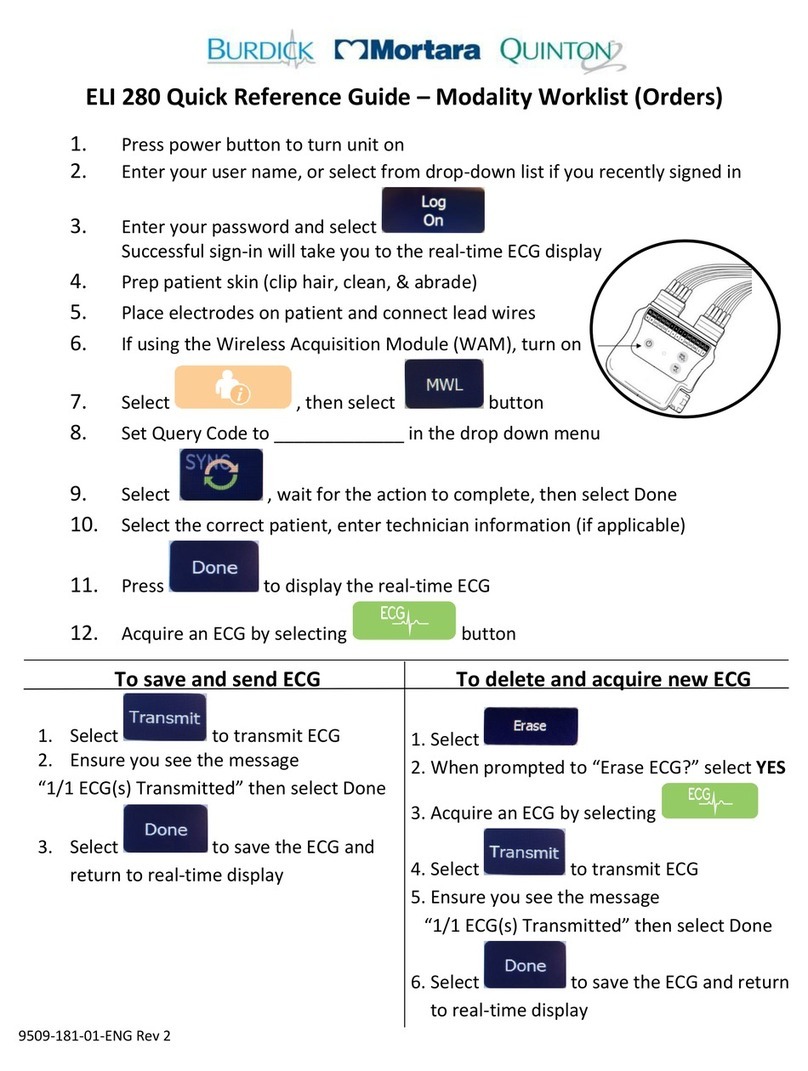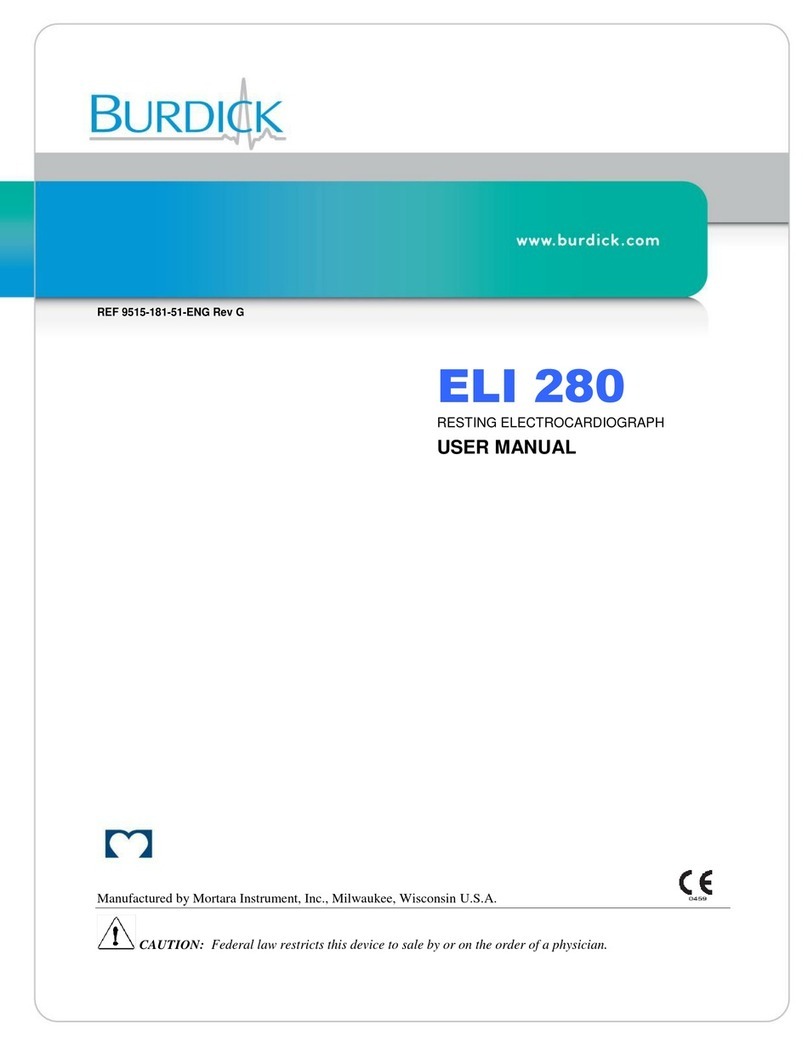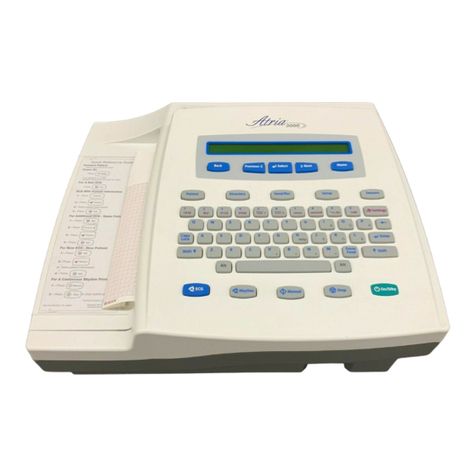Burdick E350i User manual

E350i Interpretive Electrocardiograph
Operating Instructions
(US)
-
Part No.086215
Issued:
4-93
Revised:
1
1
-93
I
Burdick,
Inc.

BURDICK E350i Operating Instructions Manual CONTENTS:
Section
1
1.o
1.1
1.2
1.3
Section
2
2.0
2.1
2.2
2.3
2.4
2.5
2.6
Section
3
3.0
3.1
3.2
3.3
3.4
3.5
3.6
3.7
3.8
3.9
3.10
*
3.11
3.12
3.13
3.14
3.15
3.16
3.17
3.18
3.19
3.20
3.21
3.22
Section 4
4.0
4.1
General Description Page
Foreword 2
lnspection
2
General Description 2
Accessories 4
Connectionsand Controls
Power Connection 5
ConnectionFunctions 5
Grounding 6
ECG Paper 6
OverloadCondition Indication 6
Controls
-
Locationand Function 7
Back-up Battery 8
Operation
OperatingModes
9
Suggestionsfor FirstTime Operation
9
PaperLoading 10
PatientEnvironment 11
Equipment Location 11
PatientPreparation 11
PatientCable and LeadArrangement (seealso6.1) 11
Disposable Electrodes(Sensors)
-
12
Applicationof DisposableElectrodes 12
Normal Operation 13
Quick Outline
-
Automatic Mode 14
The E350i Menu System 15
Operationby Menu (General) 18
PatientData Input(Demographics) 18
Setup Menus(Operating Parameters) 32
The Stress System Environment 48
Operationwith Bikeand Treadmill 54
FormatMenus (in Stress) 60
OperationinAuto Mode 64
Operationin Manual Mode 72
Artifacts
-
Causeand Recognition 76
Operationwith Filter 79
Pacemaker Mark Enhancement 79
Maintenance
PreventiveMaintenance
Cleaningand Disinfecting
Section
6
Appendix
6.0 Appendix
-
General 81
6.1 PatientCable and Lead Arrangement 82
6.2 SystemConfigurationListing 83
6.3 Flow Chartsfor NormalOperation 84
6.4 Addendum
-
FCC and Canadian D. of C. Information 89
6.5 Sample ECG Recordings 90
Section
7
Technical Data (Specifications)
*
See pages
16
and 17for page locationreferencesof specific menus.

SECTION
I
GENERAL
DESCRIPTION
BURDICK
E350i
ELECTROCARDIOGRAPH
Patient Cable
Connector
Fig.
1
.I
The Burdick E350iElectrocardiograph
1.0 FOREWORD
Your BURDICK E350i Electrocardiographis designedand manufacturedto provideconsistently
accuratediagnostic recordswith maximumdefinition and fidelity. Itis intendedfor usewith quality
ECGsupplies, such as those offered by Burdickfor the BURDICK E350i.The use of inferior
quality supplies may adverselyaffect the reliability of your electrocardiographand the
electrocardiogramsproducedby it. The useof supplies not to Burdickspecifications may also give
poor results.
1
.I
INSPECTION
Your new BURDICK E350iElectrocardiographhas been thoroughly testedand inspected priorto
shipment from the factory. Please inspectyour unitupon deliveryfor any damage that may have
occurred intransit. Ifany damage is evident, contactthe shipping agent and makea concealed
damage report promptly.
Be sureto check the accessoriesfurnished against the listof standard accessoriesfor your unit.
Any shortageof parts should be reported to your Burdickdealer.
1.2
GENERAL DESCRIPTION
The BURDICK E350iis a multi-channelinterpretiveelectrocardiographthat employsa thermal-
array print headto producehigh-definitionECGrecordsin a choiceof 3,4 or 6-channelformats.
Inaddition to its resting ECGcapabilities it can be used ina stress systemenvironment in
conjunctionwith the ERGOMED~8401840L Ergometeror with the BURDICKT500 or T600
Treadmills.

Thefollowing featuresare included:
(Fax transmissioncapability isan optionalfeature)
*
Computerizeddiagnostic interpretationand reason statements
*
Choiceof full automaticor manual operation
*
Choiceof 3,
4
or
6
channel printoutformat in Auto mode
*
Simple LCD displayfor operatorprompts
*
Fixed keyoperation of functions
*
Dependablesoft key menu selection
*
Pre-setparametersstored inon-board memory
*
Standard patient demographic input
*
Analog outputsfor 3-channelscope
*
Three paperspeeds in Manualmode
-
5,25and 50mmlsec.
*
Two paperspeeds in Auto mode
-
25 and 50mmlsec.
*
Overloadcondition indicator
The BurdickAnalysis Program:
The analysisprogramusedfor generatingthe suggesteddiagnoseswas developed by the
Glasgow Royal Infirmary underthe directionof Prof. PeterW. MacFarlane.This automatic analysis
is based upona clinicallydevelopedand tested program. The analysis criteria have beentested
on populationscomprising hospital patientsand volunteers. The programsimultaneously analyzes
10 seconds of ECGdata for each of 12 leadswhich is usedto derive the interpretivefindings. The
diagnostic interpretationsare supported by:
*
Reasonstatements explainingwhy a particular interpretation has been suggested.
*
HeartRate, PR Interval, P Duration, QRS Duration, P, QRS and T Axis Measurement,
QT and QT Corrected.
IMPORTANT
Computer assisted interpretationisa valuabletoolwhen used properly. However, no
automated interpretationis completely reliableand interpretationsshould be reviewed by a
qualified physician before treatment or non-treatmentof any patient.
OperatingModes
The unit hastwo modesof operation:automatic and manual. Inthe AUTO mode itcan acquire
recordingsof a conventional 12-leadECG in 3,
4
or
6
-
channelformat from all leads. When in this
modethe instrumentwill automaticallysequence through the leads inthe previouslyselected
format, and stop when complete.
InMAN (Manual) mode any desired leadformat, including Pediatric, Frank and Nehb lead
configurations,may be determined manually by the operator. For manual operationthe operator
selectsthe desired lead group and observesthese leadscontinuouslyon the printoutuntila new
leadgroup isselected or the acquisitionis haltedby pressingSTOP.
Patient Data:
Personalizedpatientdata can be enteredfor each recording, including:
Patientname and Patient ID number (upto 12digits).
Patientage, sex, height and weight.
Two medicationsand two clinical classificationsselected from pre-programmed lists.
Will also accept additional specific physician'scomment.

Performanceand Fitnessfor Use
Burdickinstrumentsand equipmentare designedand manufacturedusing only proven quality
components and technologyand are exhaustivelytested to ensuresafe and dependable
performanceunder normal operating conditions. However,after prolonged usage, normalwear
and tear can resultin performancedeteriorationand component failure.
We strongly recommend usingonly Burdickauthorizedservice representativesfor all serviceand
repairsand the use of only genuine Burdick replacementparts. Economicalservice contractsare
availableto helpyou maintainyour equipmentinoptimumoperatingcondition.
Forfacilities with their own BiomedicalService Staffs, Burdickalso offerstraining classesthat
enable your peopleto become expertsateffectively maintaining Burdickinstruments.
The contentsof this documentare not binding. Ifany differencesof significanceto servicework
are encounteredbetweenthe productand the informationcontained in this document, contact
Burdick, Inc.for confirmation.
We reservethe rightto modifythe specificationsand/or performanceof this productwithout
amending thisdocument or advising the user.
1.3
ACCESSORIES
Please referto the Supplement 086215-2 for a listingof both standardaccessoriesand
availableoptional accessoriesand consumable supplies
Checkthat all the standard accessorieshave been included. If any itemsare missing,contact
your Burdickrepresentative. For additional or replacement accessories contactyour dealer.
NOTE:
Your BURDICK E350i Electrocardiographisdesignedand manufacturedto produce
accuratediagnostic recordsof the highestquality and definition. It is intendedfor usewith quality
ECGsupplies; its reliabilityand performanceare directly affected by the suppliesyou use.
Use only Burdickthermally responsivechemical ECG paper or an approvedequivalent.
Table of contents
Other Burdick Medical Equipment manuals
Popular Medical Equipment manuals by other brands

Getinge
Getinge Arjohuntleigh Nimbus 3 Professional Instructions for use

Mettler Electronics
Mettler Electronics Sonicator 730 Maintenance manual

Pressalit Care
Pressalit Care R1100 Mounting instruction

Denas MS
Denas MS DENAS-T operating manual

bort medical
bort medical ActiveColor quick guide

AccuVein
AccuVein AV400 user manual














